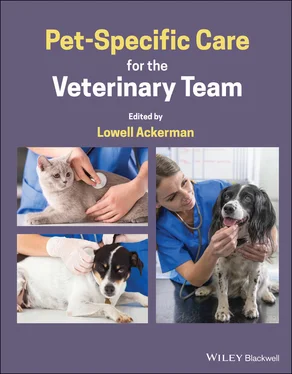2.19.5 Special Consideration for Exotic Pets and Wildlife
Clients with a love for exotic pets pose a unique challenge for VHTs. Some clients enjoy the uniqueness of owning unusual animals, including buying, selling, and breeding them. If the VHT is going to serve these clients, they need to educate themselves on the unique threats some of these species hold for people, including an increased risk of Salmonella , the threat of foreign animal diseases from newly imported animals, and handling the unique diets required by some. By understanding the unique issues these pets and clients have, team members can make handling, housing, and quarantine recommendations.
Wildlife poses a unique threat to pets and people. Some interactions cannot be anticipated but the most common threats come from clients with big hearts! As animal lovers, clients are often the first people to offer safe havens to stray pets and injured wildlife. If clients contact the veterinary office for advice, VHTs must be ready with references and safety advice. Wildlife often carry internal and external parasites that are potential threats to both humans and pets. Pets should be kept from “meeting” visiting wildlife or stray animals. In addition, team members should advise clients to safely transfer the wildlife to skilled, licensed rehabilitators. Sometimes, government laws dictate who can house and help wildlife.
2.19.6 Veterinary Healthcare Team Strategies
There is so much to consider when trying to educate clients about pet healthcare and safety, it's hard to be an expert in all areas. Rather than trying to “know” everything, team members should develop areas of expertise at least in the resources available. For example, one team member could have in‐depth knowledge of reptile zoonotic diseases and the resources to use when questions arise. Another team member would understand the potential hazards for home‐made diets and be able to consult with clients who wish (or need) to feed this way. A bit of knowledge with strong, credible resources can go a long way to keep clients and pets safe without contaminating the ecosystem.
 EXAMPLES
EXAMPLES
The Joy family has two indoor cats and a terrier mix who is a house dog but also enjoys the outdoors. On a recent hike in the neighboring woods, the family came across a friendly puppy with no collar. Of course, they picked him up and brought him home to see if they could find the owner. Although the puppy had several areas of hair loss and was scratching itself, they didn't worry because their own dog had a mild case of demodicosis as a puppy and they remembered their veterinarian saying it is rarely transferable to people. They called the veterinarian's office to see if they knew of anyone that had recently lost a puppy, but were told to call the local humane society. No other issues were discussed.
After a week, the family hadn't found the puppy's owner and took the puppy to the humane society. By now, the family's dog was itching and starting to lose fur. After a veterinary visit, he was diagnosed with sarcoptic mange, likely acquired from the visiting stray puppy. Unlike Demodex mites, sarcoptic mites can be easily spread to other animals and people. Now all the family members were at risk. This situation might have been prevented if the staff at the veterinary hospital had advised the owners to keep the puppy isolated from the house and the other pets and children.
Mr Bay raises beagle puppies for hunting and typically takes very good care of them. He is concerned about one of the puppies he has decided to keep. The puppy is staggering and not eating well. Although the technician knows Mr Bay and all about how he raises puppies, she quizzes him about the puppy's diet, travels, and where he has been keeping him. Because of the thoroughness of her questioning, it is revealed that Mr Bay recently discovered a family of raccoons in one of his barns where the puppy plays. The veterinary team warn the owner of the risk of roundworms from the raccoon's feces, as well as rabies. They also educate him about the zoonotic potential of both of these diseases. The owner chooses euthanasia of the puppy and a necropsy confirms neurological migration of Baylisascaris procyonis (raccoon roundworms).
 TAKE‐AWAYS
TAKE‐AWAYS
The VHT is a vitally important connection for keeping pets, people, and the ecosystem healthy.
VHT members need to be aware of potential zoonotic diseases that will affect their clients and patients and educate clients appropriately.
Clients preparing home‐made pet diets need special instruction in safe food handling practices.
The VHT plays an important role in preventing the misuse of antibiotics, which contributes to antibiotic resistance.
Clients need education from the VHT about handling exotic animals and wildlife to be safe from zoonotic diseases.
 MISCELLANEOUS
MISCELLANEOUS
Reference
1 1 Schwabe, C.W. (1984). Veterinary Medicine and Human Health. Baltimore.: Williams & Wilkins.
2.20 Cancer Precision Medicine
Anna Katogiritis, BSc, DVM1 and Chand Khanna, DVM, PhD, DACVIM (Onc), DACVP (Hon)2
1 I ndependent SA and Wildlife Emergency Veterinarian and NGO Consultant, USA
2 Ethos Veterinary Health, Woburn, MA, USA
 BASICS
BASICS
2.20.1 Summary
Cancer is a disease of dysregulated genes. Personalized cancer medicine (Pmed) is a therapeutic approach to pet‐specific care that most often analyzes the molecular features of a patient's cancer, and uses this information to design treatment plans that target critical genetic alterations in that patient's tumor. In so doing, this field hopes to select approaches that may more specifically target cancer cells. This approach may also allow rapid alterations in treatment in response to patient‐specific drug resistance signals that emerge during therapy and individualize monitoring of therapeutic responses. It is nearly certain that aspects of this overriding Pmed approach represent the future of cancer medicine.
Genome: This term refers to an organism's complete sequence of DNA.
Genomics:A field of molecular biology that focuses on the structure, function, mapping, and evolution of the genome.
Mutations:Permanent alterations in the DNA sequence. These can occur due to mistakes that arise during the DNA replication process, environmental factors (e.g., ultraviolet light), or infections (e.g., viruses).
Precision Cancer Medicine: An emerging field in oncology and molecular biology through which a patient's cancer is analyzed to a molecular level with the goal of identifying unique characteristics (most often specific mutations) that may respond more favorably to specific (targeted) treatments.
 MAIN CONCEPTS
MAIN CONCEPTS
Читать дальше

 EXAMPLES
EXAMPLES TAKE‐AWAYS
TAKE‐AWAYS MISCELLANEOUS
MISCELLANEOUS BASICS
BASICS MAIN CONCEPTS
MAIN CONCEPTS










